
All support functions on Fletcher’s N3114-AD/E roof bolter
can be controlled from its work basket.
Mechanization in Minimal Spaces
E&MJ looks at some recent innovations in its annual review of equipment for
narrow-vein and low-height mining
By Simon Walker, Euroean Editor

Even today, of course, there are plenty of small-scale operations around the world where little has changed, for good reason in many cases. Following narrow- vein deposits can demand a level of accuracy that test’s a miner’s skills, while the need to minimize dilution is purely economic. In operations that are under- capitalized, with little spare cash for investment in both the machines and the support infrastructure needed to make the job easier physically, the status quo is as good as it gets.
That take on working life does, of course, assume that there is an adequate supply of labor that either already has, or can be taught, those skills that are needed to drive headings, stope ore and install whatever support is needed safely, efficiently and cost-effectively. And this is where the benefits of introducing an appropriate level of mechanization can be found—in relation to safety in particular.
One very clear trend to emerge over the past few years has been the introduction of drills, loaders and haulers powered not by diesel, but by electricity. With its cable- and battery-powered shuttle cars, the coal industry was ahead of the game in this respect, but hard-rock mining is now not only catching up, but is setting new standards for electric-powered machines.
And, with the recognition that power cables have disadvantages in terms of their operating radius and their vulnerability to damage, the focus is now on a new generation of battery-powered equipment. Driven by rapid increases in demand for capacity, rechargability and weight reduction, much of which has come from the automotive industry, battery technology has advanced at an amazing rate in the past 10 years or so. New concepts have been developed in the materials used, with today’s heavy-use battery light-years ahead of the lead-acid units that powered the mining locomotives of the mid-20th century.
Understandably, the manufacturers’ main thrust has been toward the introduction of this type of technology to those market segments likely to generate the most sales. Yet the signs are already apparent that battery power is reaching machines for narrow-vein mining as well. In addition to the improvements to the working environment for the machine operator, and the enhanced safety from avoiding the use of diesel fuel underground, the need for lower ventilation volumes can offer significant energy savings. All-in-all, electric power in general, and battery power in particular, looks like a winner for narrow-vein operations.
Aramine’s Battery miniLoader
With the launch of its battery-powered
L120B miniLoader scheduled to take
place at MINExpo 2016, the French
company Aramine told E&MJ that it has
created a real revolution in narrow-vein
mining equipment. This will be the first
in a new range of ecofriendly machines
for this market, the company explained,
bringing safety and working environment
benefits while helping narrow-vein operations
achieve good productivity.
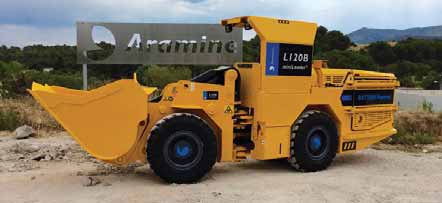
Simple to operate yet robust enough for the tough mining environment, the new L120B is powered by a lithium iron phosphate rechargeable battery pack—and is delivered with two of these packs to ensure productivity. In addition, it brings a major improvement in terms of safety compared to standard electric machines since there is no longer any need for a cable. This in turn gives the loader a greater working area as well as enhanced freedom of movement.
Aramine pointed out that not having a cable also means that there is no need for a reel mounted on the machine, cutting maintenance requirements and improving its overall reliability—as well as saving the cost of the expensive cable.
Since battery charging has a constant power draw, operation does not produce the current peaks and voltage drops associated with the use of cable-fed machines. In consequence, the company said, narrow- vein mines will be able to use a lower- capacity electric network infrastructure, also giving better network reliability as well as lower capex costs for its installation.
Bolters Bring Better Safety
J.H. Fletcher & Co. currently offers three
machines specifically for narrow-vein
mines: The J101-AD/E single-boom drill
jumbo, and the N3114-AD/E and N3016-
AD/E roof bolters.
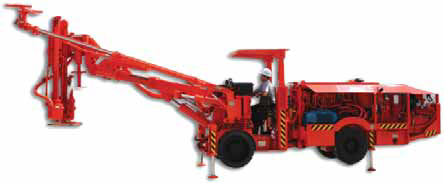
Loading, drilling, resin insertion and bolting are all performed from the control deck, allowing the operator to remain under the protective canopy. An enclosed filtered cab with air conditioning and heating is also available as an option, further protecting the operator from noise, diesel particulates and dust.
The N3114-AD/E is designed for use in headings down to 2.4 m (8 ft) wide. The drill unit can reach a maximum height of 4.4 m (14 ft 6 in.), which eliminates the need for stope backfilling before roof support can be installed. With an articulating chassis, the machine can negotiate turns with as little as 2.5 m (8 ft 3 in.) inside radius.
Drilling, resin insertion and bolting can all be performed from the operator’s boom-mounted basket, with canopies providing additional protection to the operator in both the driving and workbasket positions.
Meanwhile, the J101-AD/E drill jumbo is designed for narrow-vein applications with an overall width as small as 1.4 m (4 ft 8 in.). As with the other machines, it has diesel-powered tramming and electric drilling.
Equipped with proportional control of tram and boom functions, it can also accommodate a variety of rock drills.
GHH to Launch New LHDs
Together with Hazemag, Mine Master and
mts Perforator, GHH Fahrzeuge is part of
the Schmidt, Kranz group’s “Mining Alliance.”
For narrow-vein mining, the company
offers LHDs with 3-, 4.5- and 6-mt
payloads as well as 15- and 20-mt-capacity
dump trucks, while its low-profile
portfolio includes LHDs, mine trucks and
scaling units.
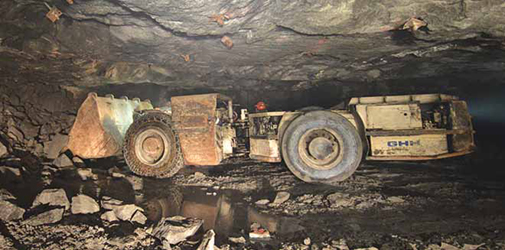
The company recently updated its 4.5-mt-payload LF-5 and 6-mt LF-6 LHDs with Tier 3-compliant engines, with a Tier 4 engine available for highly regulated markets. GHH claims that the LF-5 has the largest payload and power-perweight ratio of its class, with a simple yet robust design that gives good availability.
GHH’s low-profile LHD range covers payloads from 3 mt to 14 mt for both softand hard-rock applications. The SLP-3H and SLP-14H units are designed for softrock mining and have hydrostatic drivetrains, while the company’s four hard-rock (platinum and chrome reef mining) machines cover payloads from 5 mt to 10 mt. In addition, the new 21-mt LF-21H LHD is available in a low-profile version.
Mine Master’s Dual-role Drill
Mine Master designed the Face Master
2.5NVDR development drill rig specifically for narrow-vein operations, aiming to
minimize waste dilution. Capable of being
adapted quickly and easily between face
drilling and vertical long-hole drilling, even
in tight headings, the rig uses a heavy-duty,
two-axial rotary actuator to change its
drill position from horizontal to vertical. An
additional dump cylinder holds the drilling
carriage in balance, so that it can always
be orientated with the direction of working,
independent of the boom direction.
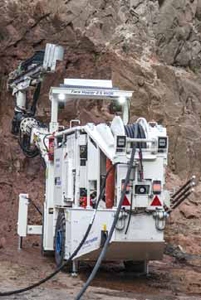
Being a dual-purpose machine, the FM 2.5NVDR allows narrow-vein mines to standardize on drill equipment. Fewer spares are needed, while operator and maintenance training is focused on just one machine type.
Mine Master’s Face Master 1.4 lowprofile drill rig has recently been given a water-cooled Tier 3-compliant engine as well as upgrades to meet the latest South African requirements. The hydraulic system has been modified to change quickly between blasthole and reamer drilling, which require different drifter setup parameters in terms of rotation and torque.
Joy Builds its Narrow-vein Range
Following its purchase of Canadian company
MTI two years ago, Joy Global (itself
now in the process of becoming part of
Komatsu) used MTI’s product portfolio
as the basis for its new hard-rock underground-
mining division. According to
Doug Eamer, the company’s manager of
commercial and product management,
Joy’s narrow-vein product line currently
consists of 10 models of LHDs, trucks
and development jumbos. In addition, he
told E&MJ, there are five new narrow-vein
machines in the pipeline, the first of
which, the 4-mt-capacity 4LD LHD, will
debut at MINExpo.
Eamer said the 4LD has a robust steel frame designed to help reduce downtime and extend equipment life. Joy claims that the machine offers best-in-class radial turns, ground speed and bucket action, while the Z-bar link bucket is the first to be implemented on an LHD of this size class. This improves the bucket dump time and allows the installation of a large enclosed cab—also an industry first, Joy said.
Joy’s most recent truck offering, the 16TD, has a focus on safety, featuring ground-level maintenance, three-point access and egress to the operator’s cab, operational interlocks, and the separation of heat and fuel sources.
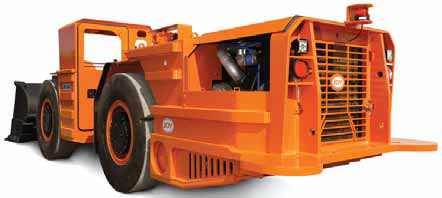
Atlas Copco’s Drill-rig Milestone
In May, Atlas Copco announced the
availability of its first battery-driven
product for mining—the Scooptram ST7
Battery. And while a 6.8-mt carrying
capacity may be on the high side for really
narrow haulages, the company has
set out its intentions clearly enough.
“To make the greatest impact on the
work environment and ventilation costs,
a battery-driven loader was an obvious
choice,” said Lars Senf, marketing
vice president.
At the end of 2014, Atlas Copco upgraded its Scooptram ST7LP low profile loader with a fully enclosed operator’s cab. Benefits over the previous canopy- only protection include full ROPS/ FOPS protection, air conditioning and lower noise levels.
Late last year, Atlas Copco reported that it had then supplied more than 500 Boomer S1 D narrow-vein drill rigs since the model was launched in 2011. Delivered to the Sasa lead-zinc mine in Macedonia, the milestone unit joined a fleet of four S1 D rigs, five Scooptram ST3.5s and one ST7 and two Diamec 232 core-drilling rigs.

The most recent addition to the range, the PFL 20, is a small machine with a 4-mt capacity. Paus is soon to launch its 1-mt-capacity PFL 5, while next year will see the introduction of the PFL 8 with a battery and a battery hybrid driveline.
Paus has also added to its utility vehicle range with units designed for small drifts. On show at MINExpo, the new Minca 5.1 man carrier is only 1.7 m wide and 1.7 m high, and is available with several diesel options and a newly developed battery hybrid driveline.
Another addition for confined spaces, the Universa 40 is an articulated utility vehicle similar to the Universa 50, but again smaller and lighter.
Paus now uses LED lighting systems on all of its machines to provide better visibility, while other standard features include ROPS/FOPS cabs and fire-suppression systems.
Boart Longyear: Capacity With Compactness
As has been described in detail in our
previous narrow-vein equipment reviews
(September 2015, pp. 52–57 and March
2014, pp. 28–35), Boart Longyear’s
StopeMate and StopeMaster long-hole
rigs are compact, yet can offer hole
depths of up to 25 m and 35 m, respectively.
The StopeMate in particular is designed
to operate in extremely confined
spaces, and can be moved from level to
level in a man cage without being broken
down into its main component parts.
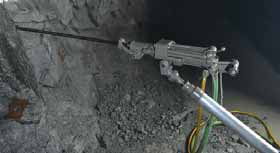
More on Sandvik’s DD211
Sandvik’s product portfolio for narrow vein
applications includes both drill
rigs and loaders. Examples include the
DD211 single-boom electrohydraulic development
rig, launched in 2013, and the
LH204E 4.5-mt-capacity electric LHD.
Both have been in E&MJ previously.
Benefits claimed for the DD211 include its compact size and its ability to carry out all three of the main tasks needed in narrow-vein mining: development drilling, cross-cut drilling, and drilling production and bolt holes in the back and sidewalls.
Speaking at the time, Sandvik’s product manager, Johannes Välivaara, explained the company’s view. “Many of the easily extractable narrow-vein deposits have been depleted, and the remaining, less-accessible reserves call for more advanced technology,” he said. “The DD211 has advanced safety and ergonomic features that help prevent accidents and also make it easier to attract and retain a skilled workforce. Better, safer working conditions also improve productivity.”